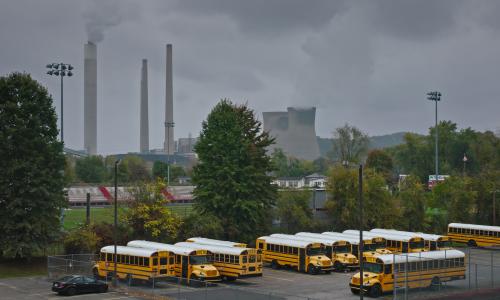Nuclear waste is piling up in our backyard—and it's not stored as safely as it could be.
Radioactive nuclear waste is piling up
Nuclear power plants produce large amounts of waste, in the form of spent fuel assemblies, which are collections of fuel rods. These 12-foot-long metal tubes contain uranium, plutonium, and other metals and byproducts, and are extremely hot and radioactive.
The United States has not fulfilled its commitment to move spent fuel from reactor sites to long-term storage. As a result, well over 65,000 metric tons of spent fuel assemblies have piled up at our nation's nuclear power plants—and the pile is growing.
Learn more about storing radioactive waste (PDF).
Cooling pools are overcrowded, posing unnecessary risks
Currently, over 70 percent of U.S. spent fuel assemblies are kept in cooling pools at U.S. reactor sites. These pools are designed to store hot, radioactive spent nuclear fuel for several years, and rely on electrical systems to cool and circulate water.
As spent fuel piles up at reactors, most operators continue to store it in pools. As a result, cooling pools now hold significantly more nuclear material than originally intended. In fact, while concern tends to focus on the nuclear fuel in the cores at operating reactors, U.S. cooling pools contain some five and a half times more nuclear material than the reactor cores themselves—with far fewer safety systems.
While storing nuclear waste in cooling pools is safe under normal conditions, a severe accident or terrorist attack that interrupts cooling for hours or days—depending on the scenario—could have catastrophic consequences, made worse by overcrowding.
A 2013 study by the Nuclear Regulatory Commission (NRC)—the U.S. government agency charged with nuclear power plant safety—estimated the results of such an event. Using the Peach Bottom #3 reactor in Pennsylvania as an example, the study found that a cooling pool accident could contaminate thousands of square miles with radioactive material, force the long-term displacement of millions of people, and cause tens of thousands of cancer deaths.
The study didn't consider the results for pools located closer to major urban areas.
Learn more about cooling pools.
Dry casks are a safer short-term storage option
After about five years in a cooling pool, spent fuel cools enough to be transferred to concrete and steel containers called dry casks.
Dry casks are designed to store small amounts of nuclear waste on-site before long-term disposal. Current designs can also be used to transport the waste off-site.
Unlike cooling pools that rely on electrical systems, dry casks employ “passive” cooling: air enters an opening at the bottom of the cask, absorbs heat from the spent fuel, then rises and exits through openings at the top, creating a “chimney effect."
Passive cooling makes dry casks less vulnerable to mechanical failure, technical or human error, terrorist attack, and natural disaster.
Transferring nuclear waste from cooling pools to dry casks could save lives
Today, around 80 percent of U.S. nuclear waste currently in pools could be moved to on-site dry casks.
Doing so would reduce the amount of nuclear material in each cooling pool to about one core's worth, significantly lessening the consequences of a pool accident. In fact, the same NRC study cited above shows that removing spent fuel older than five years from a cooling pool could reduce the projected number of accident-related cancers by a factor of 10, and the total amount of uninhabitable land by a factor of 50, compared to the results given above.
What's more, moving spent fuel into long-term storage underground will require they be placed into transportable dry casks anyhow. Doing so today will significantly lessen the potential consequences of a cooling pool accident.
While improbable, accidents at nuclear power plants do occur. It's up to Congress and the NRC to minimize the potential consequences.
Methodology
The 2013 NRC report referenced above estimates the consequences of a severe accident affecting the cooling pool at Peach Bottom #3. It compares the consequences of a “high density” pool—one that contains about four cores (3,000 assemblies) of spent fuel—with those of a “low density” pool—one that contains about one core (764 assemblies) of spent fuel (Table 15, p. 76). The low density case assumes that all spent fuel that has been in the pool longer than about five years has been removed.
The NRC estimates are given in Section 7 of the report, which begins on p. 150. The results are summarized and compared in Table 37 (p. 170), which shows how the consequences of an accident, should it occur, are reduced by transferring fuel out of the pool. Row four of Table 37 gives the collective radiation dose that the population around the reactor would receive. To convert this dose into numbers of cancer deaths, multiply this number by the risk coefficient, which at low doses is 0.05 per person-Sv.
That calculation gives an estimate of 17,500 deaths for the high density case and 1,350 deaths for the low density case.
Rights and permissions
You are free to use and post this infographic without alterations online, in written materials, and in presentations. We request that any online use includes proper citation and a link to this web page.



